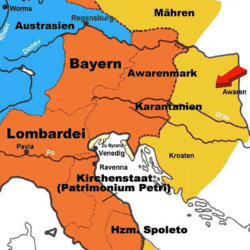Avar March
The Avar March (Avaria, German: Awarenmark) was a southeastern frontier district of the Carolingian Empire, established in the late 8th century by Charlemagne against the Eurasian Avars on the Danube River, in what is today Lower Austria.
History
Since about 560, the Avars had ruled over large parts of the Pannonian Basin and Carantania southeast of Francia, though in the last decades, the Avar Khaganate had to deal with Bulgarian and Croat incursions. To secure the frontier of his empire and the traffic on the trade routes to the east, Charlemagne allied with Khan Krum of Bulgaria and the Croatian duke Vojnomir, and from 791 launched several campaigns against the Avars, where he, according to the Vita Karoli Magni, encountered only modest opposition. In 796 Carolingian forces under Charlemagne's son Pepin of Italy destroyed the main Avar fortress called the Ring of the Avars and made the Khagan a Frankish vassal, while the remaining Avars retreated behind the Tisza River. The victory is perpetuated by the poem De Pippini regis Victoria Avarica.
Charlemagne set up the Avar March east of the Enns River. The frontier districts of Avaria and Carantania stretched along the eastern Bavarian border, from the Danube Basin down to the Drava and beyond to eastern Friuli, in order to protect the empire from any future attacks from Pannonia. The military command of the Avar March was given to the Alamannian count Gerold of Vinzgau, his son Gerold the Younger, and Eric of Friuli, who ruled as margraves with authority over the local counts and the right to call up the levy (Marchfutter).
While new threats were imposed by Duke Ljudevit of Croatia and the Great Moravia rulers, the Avars disappear from the records in the 820s and so the Avar March with them. With Bavaria, its eastern march (marcha orientalis, also March of Pannonia) became part of East Francia upon the 843 Treaty of Verdun. The adjacent Pannonian Basin beyond the Leitha and Morava (March) Rivers in the east was settled by the Magyars about 900, who also conquered the former Avar March at the 907 Battle of Pressburg. It was not until 955, when the German king Otto I regained it upon his victory in the Battle of Lechfeld. When in 976 his son Emperor Otto II raised the vast Bavarian March of Carinthia to a duchy, the remaining marcha orientalis along the Danube emerged as the March of Austria (Ostarrîchi).
